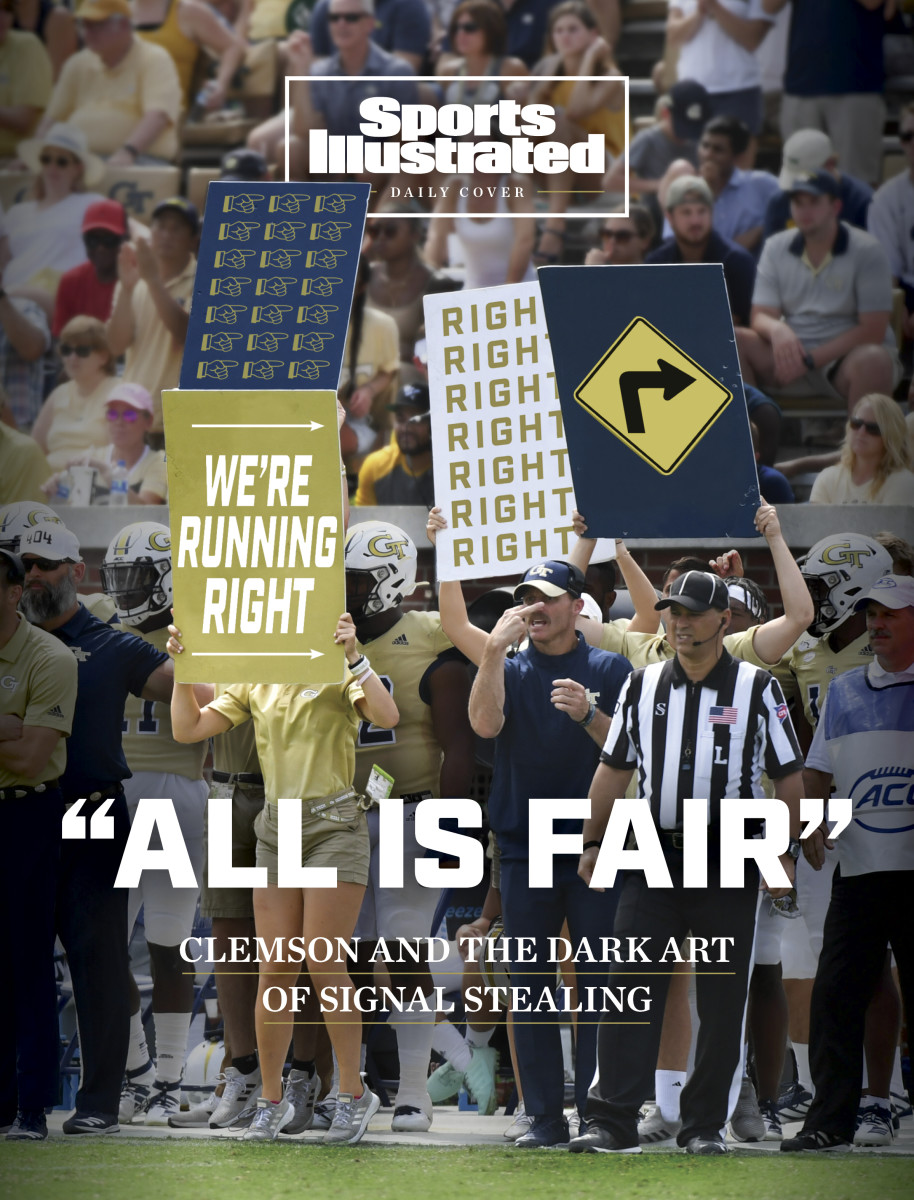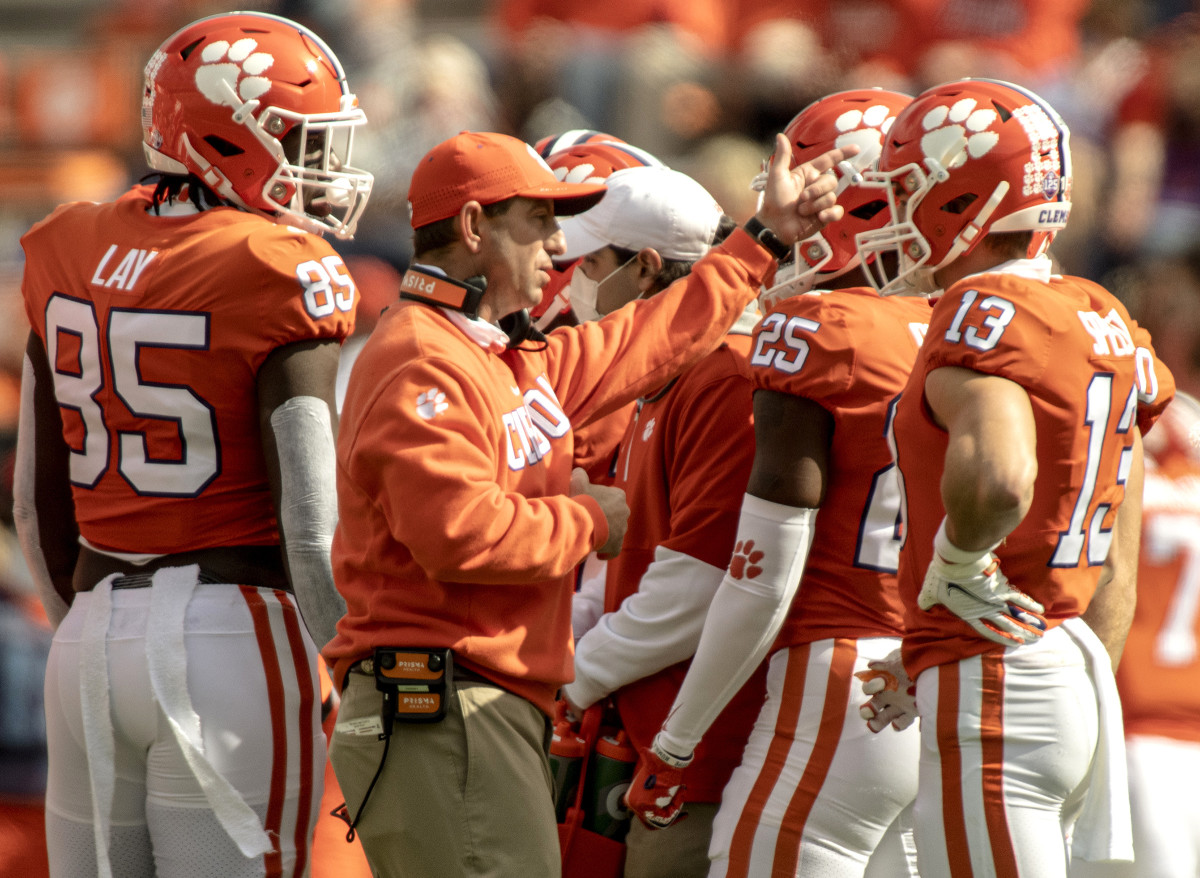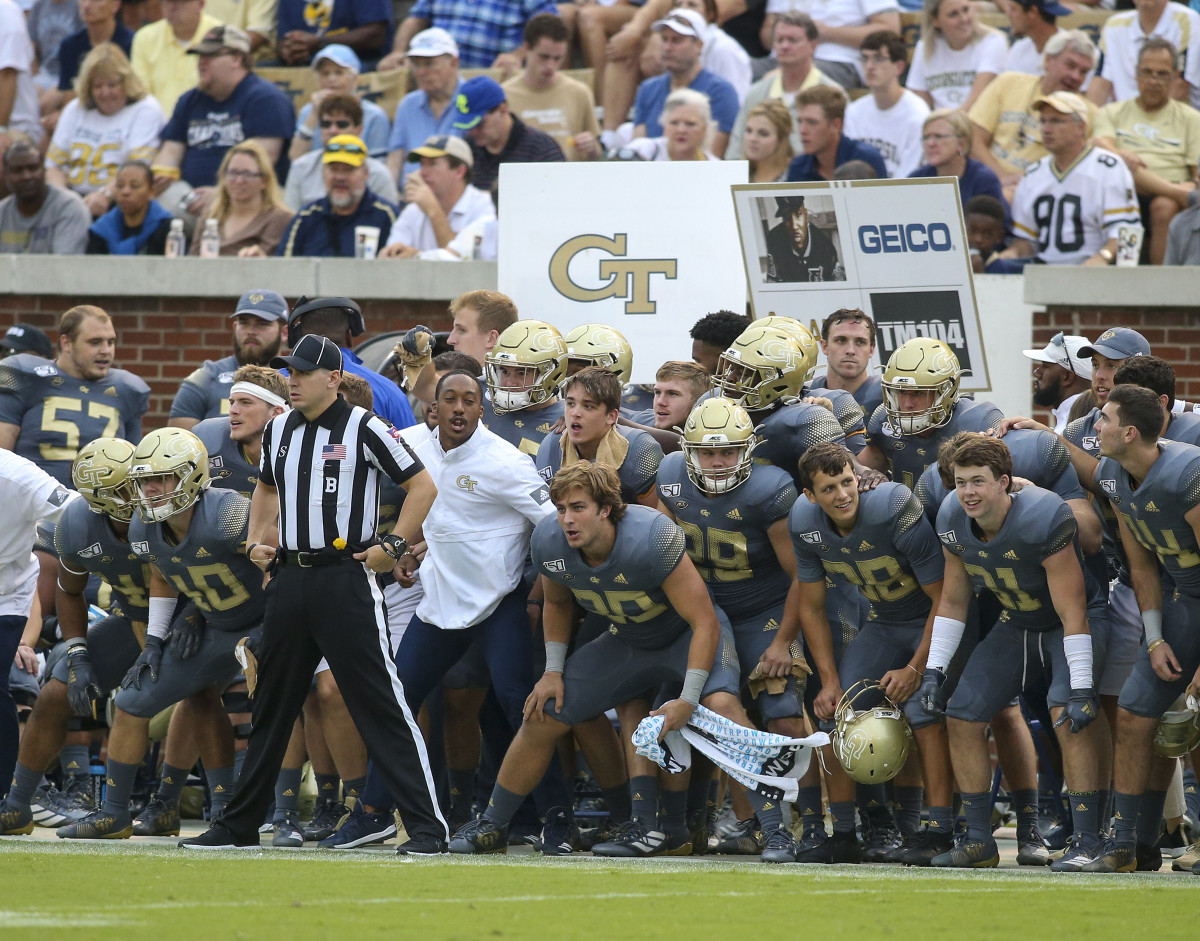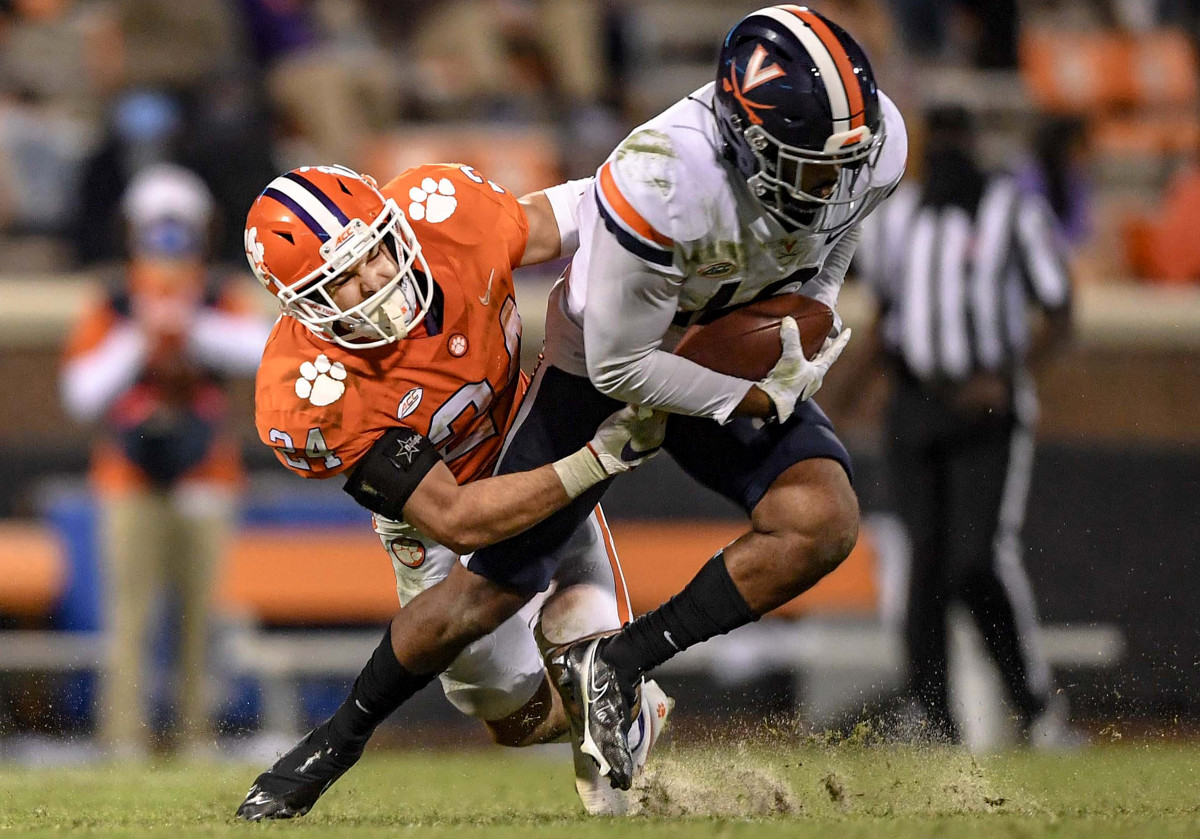Follow the Signs: How Clemson Football Mastered the (Totally Legal) Art of Signal Stealing
A month ago, Miami offensive coordinator Rhett Lashlee said the quiet part out loud. He was asked on a Zoom call about Clemson’s reputation for stealing an opponent’s offensive signals that are used to relay play calls from the sidelines, and he met the question head on.
“Clemson is known well for doing it,” Lashlee said.
He went on to both downplay any implication that it was either rare or nefarious—this is no Houston Astros trash can scandal. "That happens everywhere," Lashlee said. "It's just part of the game. We have to be aware of it, but at the same time, we have to go play. There’s nothing in the rules against stealing signals. Just like in baseball—if you can catch on to a signal that a guy is stealing second, you might as well throw him out.”

Let’s throw this out there: If you ask around college football, you’ll hear that stealing signals can be as much a part of the game as blocking and tackling. It is a commonplace means of trying to gain a pre-snap advantage. But after talking to coaches and staff members at half a dozen teams that have played Clemson in recent years, here are the three responses that follow:
- Knowing laughter.
- An acknowledgement that the Tigers are an elite signal-swiping program.
- “That’s off the record.”
This isn’t the first time the topic has arisen. In its 2017 college football preview magazine, Athlon Sports quoted an anonymous coach saying, “They’ll steal your signals. … It’s not a very well-kept secret.” A year earlier, head coach Dabo Swinney tacitly acknowledged the hustle in a story in the Raleigh News & Observer, saying, “You’re in a competition. You’re competing and you want to get every edge that you can. If you have an opponent who’s basically screaming out, ‘Hey, we’re running the ball,’ well, that’s an advantage.”
Nobody is denying it, but no Clemson opponents have been eager to talk publicly about it, either. While signal stealing is a commonly accepted element of the sport that violates no written rules, it does traipse into the sportsmanship gray area—and coaches are loath to talk about opposing teams in that regard. Especially when the opposing team is Clemson, which has the talent to run up scores on just about anyone if it so chooses.
Lashlee was the outlier, willing to call the Tigers what they are—masters of the art of the steal.

Exactly how they do it, and how much it helps, remains a bit mysterious. But within a sport that is steeped in paranoia—play sheets routinely covered coaches’ mouths, back before masks did—everyone raises their guard a little higher when playing Clemson, which declined to comment to SI for this story. Swinney’s team has the Atlantic Coast Conference preparing for more each week than just the Tigers’ talent, toughness and gameplan.
“Clemson has that reputation,” said a staffer at another ACC school.
“Clemson is the best in the country at stealing signals,” said one ACC coach.
“They really utilize it on the defensive side of the ball,” added another coach in the league. “They are really good at it. One time we got in a formation that is 90% run, and they dropped eight (defenders in coverage). They knew it was a pass call. It was like, ‘Are they listening to our headsets?’ ”
Next up to deal with No. 1 Clemson’s covert ops team is No. 4 Notre Dame, in a game with major ACC and College Football Playoff implications. It's not the first time the Fighting Irish have played the Tigers in a high-profile game, having lost 30–3 in the 2018 CFP semifinals. Let's just say that Brian Kelly knows what he's getting into with Clemson, and has put some thought into how to counter program anything the Tigers have picked up from their signaling this season.
"I think you have to be cognizant of it and be aware of it," Kelly said Thursday. "No question, it's something we are dealing with. We've lived it, and we're prepared for it.
"When you come down to the execution part of it, you want to give your team a chance to execute without anything being tipped off. Whether it's wrist banding more—we're looking at all the alternatives."
As offenses moved away from huddling and toward signaling in plays as their unit lined up, that created both additional stress on the defense and additional opportunity to figure out what play was coming. For many no-huddle teams, sign boards were in vogue for several years, but those haven’t been seen as much lately (some coaches interviewed for this story said most of those were fake eye candy or tempo signals more than actual play calls). Primarily, plays are sent in via human signalers.
Clemson defensive coordinator Brent Venables is paid more than $2 million a year for many reasons—he can teach the game, he can recruit elite players, he can build a defensive gameplan. But he’s also a gifted in-game caller, and some of that is built upon what his spies are telling him.

What makes Clemson so good at the art of the steal? Primarily this: a massive staff that can allocate time and resources to the craft. The school has gone all-in on football spending, and it shows in both its facilities and the staff page on the Clemson football website.
The page includes names and faces of 74 people (although they no longer list the pilots for the team’s charter flights, which had been a feature of past Clemson staff listings). Among the group are 15 analysts or graduate assistants, which is usually where teams employ their code breakers. “They’ve got a ton of people in their building,” one coach said. “They’ve got the most money and the most people.”
That’s a larger number than the vast majority of Power 5 programs, and the Tigers put them to good use. NCAA teams are allowed 60 sideline passes for use within the coaching box, which runs from one 25-yard-line to the other in normal seasons (that has been expanded due to COVID-19 social distancing protocols). Several ACC schools said that Clemson is known for requesting 20–40 additional sideline passes for the travel party to use at field level outside the coaching box.
Are those requested passes for the code breakers? Some of them, maybe. Opponents certainly suspect it.
Surveillance also can come from above, in the coaches’ box. There is a reason some staffers (for every team) often carry binoculars with them when they go upstairs. All the better for spying on the opposing sideline.
But all of that is just on game day. The espionage starts well before then. A longtime defensive play caller provided SI with the basic background on how he and his staff spent a typical game week compiling information on an opponent’s signals:
“Your GAs, as soon as you turn the page to the next game, they’re getting new tape,” he said. While the coach’s tape (often referred to as the “all-22” video, because it shows every player on the field) is preferred for studying scheme, it doesn’t help as much with signaling. So GAs usually scour the TV tape, which includes an abundance of sideline shots.

Those shots are logged into a database and compared to the actual plays. Which signals correspond to running plays, to passing plays, to specific formations?
In addition to breaking down the video and building a database, the GAs (and the rest of the staff) will make phone calls to friends and acquaintances on other coaching staffs that have played the upcoming opponent. Among the questions: Did you get a bead on signals? “Everybody is going to call somebody they know and find out every little thing.”
Some staffers have a gift for picking up signal combinations and patterns. Some are adept at reading body language—they can pick out a dummy signaler because he won’t put as much effort into the fake signals, for example. “The guys I had that are good; they have a knack for studying people,” the veteran defensive play caller said. Added another coach: “We had a guy who could find something the other team would do, every single time, when they signaled in a protection or something.”
Once a book of sorts has been compiled on an opponent’s signaling, the next step is implementing and disseminating that information during a game. Visiting coaches are always cognizant of where the press box is, and what sort of viewing angle it provides to the field—for them and for their opponent. Some home teams choose which sideline their team is on based on surveillance opportunities from the press box. “You see a lot of teams shielding their signals from behind if their sideline is on the press box side,” one coach said.
The next issue is headset allocation. NCAA rules limit the number of people per team who can wear a headset to 23. It helps if your best code breaker (or two) are on headsets to communicate directly to the defensive coordinator. Then it’s a question of how much time the code breakers have between play signal and snap of the ball. “You may know what’s coming,” the veteran defensive coach said, “but can you let your kids know in time?”
Adjusting the decoding during a game is frequently required, because most teams will switch up their signals from week to week. (Although many coaches have go-to signals they will keep using, even if they adjust many of the others.) Which means the information your GAs accumulated leading up the game might be outdated by kickoff. The sharp ones can start over and decode on the fly during a game.
But the defense needs to play signal defense, too. Offensive coaches are looking for sideline intel as well. “It absolutely goes both ways,” the defensive coach said. “I’ve had our coaches in the box say, ‘Coach, turn your grease board sideways. I can see what you’re writing.’ And I’ve had players come off and say, ‘Coach, they’ve got you figured out. They know when we’re in Cover 2.’ It’s definitely influenced me the last five years, the way I call games.”
Coaches aren’t going to intercept every play call. And the most important advantage remains talented players who can execute a good gameplan. But does the occasional stolen signal help? “If you’ve got ‘em, you’ve got ‘em,” the veteran defensive coach said. “There’s no question, from a play-calling standpoint, it helps put your guys in a position to win.”
As for Clemson: Venables is a notably late defensive play-caller, usually waiting to see how the offense lines up and then firing off his own signals and calls in the few seconds he has before the ball is snapped. The coaches who spoke to SI for this story attributed that to waiting for information from his code breakers.
“They have an army of support personnel,” one coach said. “That’s why Venables gets the calls in so late. I’m not sure of the chain of communication to Venables, but he waits for it.”
Opponents identified three ways to try to counter Clemson’s signal stealing: overloading the spies with junk information, huddling, using wristbands with play sheets on them, or juicing the tempo so fast that Venables doesn’t have time to read and react.
North Carolina, which nearly beat the Tigers last year in Chapel Hill, implemented a “sugar” huddle (short and sweet) for that game. North Carolina State and Pittsburgh, other ACC teams that either beat Clemson or came close within the last five years, huddled during those games.

LSU threw everything at the Tigers in the CFP championship game last season—sign boards, hand signals and a lot of tempo. LSU lit up Clemson for 42 points, 628 yards and 7.75 yards per play, the most points Clemson has allowed since 2016, the most yards in the Swinney era and the most yards per play since 2012. But was that a product of foiling sign stealing, or a product of Joe Burrow and the rest of the LSU offense being brilliantly talented and expertly coached?
Of greater insight might be the game that preceded the loss to LSU. That’s when Clemson eked past Ohio State in the CFP semifinals, 29–23. In that game, the Tigers fell behind 16–0 before slowing the Buckeyes down and rallying.
In Ohio State’s first five possessions, it produced four scoring drives and 290 offensive yards on 35 snaps, 8.29 yards per play. The next eight possessions led to one scoring drive, 243 total yards and 4.86 yards per play. Did Venables’s support staff crack the Buckeyes’ play-calling code during the game? A couple of staffers at other schools suggested it.
In a sport rife with espionage and intrigue, figuring out what’s coming before the snap—by any means necessary—is just part of the game.
“All is fair,” said one coach well-practiced in the dark art of signal stealing. “It’s on you if you’re dumb enough to leave your signals out there. Any way I can get an advantage, I’m going to take it. It’s competitive, man.”
Read more of SI's Daily Cover stories here.
More Clemson Coverage From SI.com:
Clemson Expects Notre Dame to Attempt to Limit Travis Etienne
Swinney Glad He Landed 'Special, Special Talent' in D.J. Uiagalelei
Clemson Will Have 'Coach Lawrence' vs. Notre Dame
